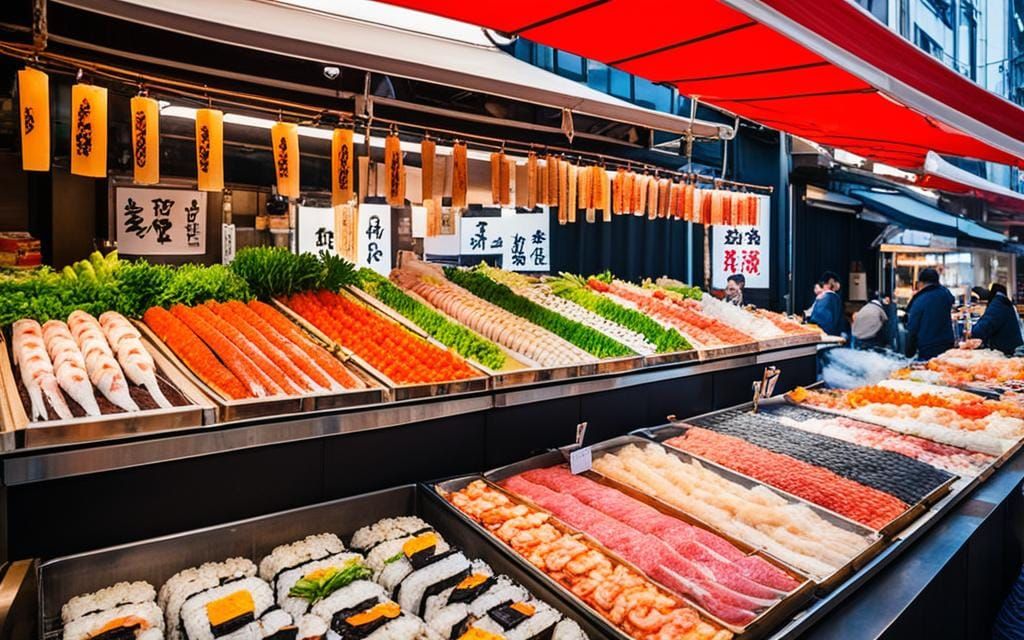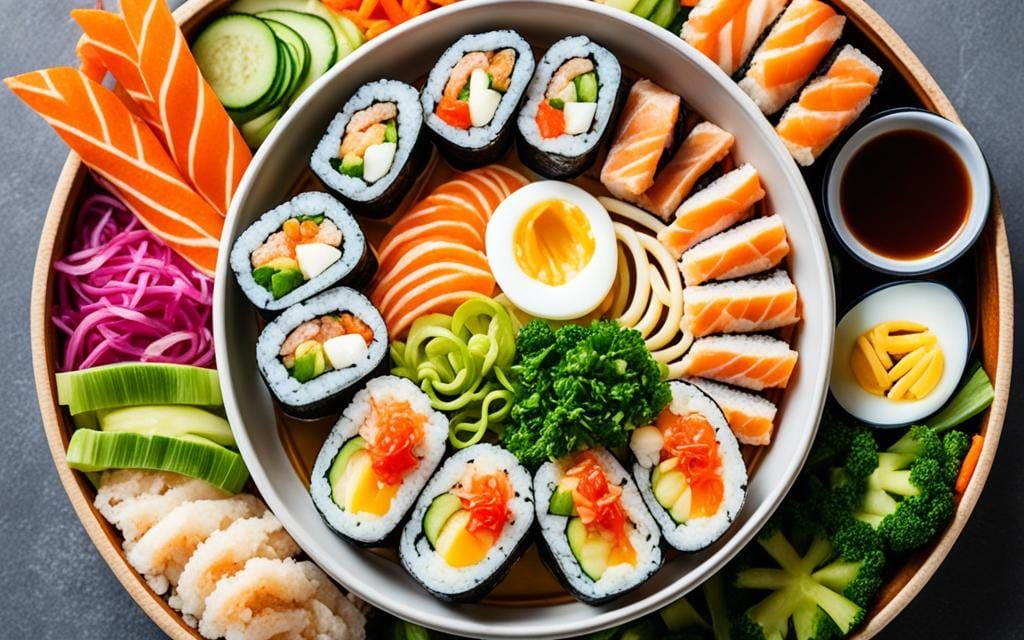Japanese Food Culture – In Japan, cooking is more than just making food – it’s a true art. Japanese cuisine is loved for being simple, yet precise, and for its long traditions. Food lovers from all over the world are drawn to it.
This article invites you to discover the rich flavors and delights of Japanese food culture, where umami rules. We will dive into the Japanese culinary philosophy and share the secrets of key ingredients. By the end, you’ll understand and admire the art behind this special cuisine.
Table of Contents
ToggleThe Japanese Culinary Philosophy
Japanese cuisine is more than just food. It carries a deep cultural philosophy developed over centuries. At its heart is wa, which means harmony in Japanese. Wa is about the balance of different elements, like flavors, textures, and seasons, in one meal.
This balance is not just in food but in life as well.
Harmony and Balance
The core of Japanese cooking is about finding harmony and balance. Chefs aim to combine a range of flavors, textures, and looks in their dishes. Everything in the dish works together to create a perfect overall taste.
This commitment comes from the Japanese values of simplicity and appreciation for nature’s beauty.
The Role of Umami
Umami, often called the “fifth taste,” is crucial in Japanese food. It’s a savory flavor that makes food more delicious. Ingredients like seaweed, mushrooms, soy sauce, and bonito flakes are rich in umami. Chefs use umami to add unique and satisfying tastes to their dishes.
Seasonality in Japanese Cooking
Seasons play a big role in Japanese cuisine. The Japanese deeply value changing seasons, and this shows in their food. Each season brings its own special ingredients.
Chefs highlight these seasonal offerings in their dishes. This practice connects the meals to the current season’s natural beauty.
Essential Ingredients
Japanese cuisine is known for its unique flavors achieved through careful selection and preparation. The “Holy Trinity,” made up of soy sauce, mirin, and sake, is key to Japanese seasoning. They significantly enrich the taste of countless dishes.
The Holy Trinity: Soy Sauce, Mirin, and Sake
Soy sauce lays the foundation, imparting dishes with a rich umami flavor. It’s joined by mirin, offering sweetness to balance soy sauce’s saltiness. Additionally, sake is used to tenderize meat and improve the complexity of sauces and soups.
Freshness and Quality: Seafood and Sushi
Japan, being an island nation, benefits from a vast supply of fresh seafood. This is evident in sushi and sashimi, where the raw fish or seafood shines. These dishes highlight the best of Japan’s marine bounty.
Essential and Versatile: Rice and Noodles
Rice and noodles form the base of many Japanese dishes, allowing for a great variety of meals.
A Symphony of Flavours: Dashi and Miso Paste
Dashi, a flavorful broth, is instrumental in many Japanese dishes, serving as a base. It’s used in soups, sauces, and more. Miso paste, derived from fermented soybeans, adds a rich, salty taste to a range of meals.
Traditional Japanese Dishes
Japanese food is well-known for its yummy, traditional meals. Each dish carries special tastes, feels, and deep meaning from the culture. Sushi is a standout example, loved across the globe for its simple yet delicious flavors.
Sushi: The Art of Precision
Sushi-making is all about being exact and creating a harmonious dish. Nigiri sushi is a small bite of vinegared rice topped with fresh seafood. It’s all wrapped with a thin seaweed strip (nori). Maki sushi, or sushi rolls, take rice, seafood, and veggies, roll them in nori, then cut into pieces. Whether you fancy something luxurious, affordable, or in-between, Japan has sushi just right for you.
Where to Eat Sushi in Japan
For top-notch sushi in Tokyo, Sukiyabashi Jiro is unmatched. For great value, Sushizanmai is a must-visit. Over in Osaka, Fuji Sushi and Harukoma Sushi shine for big, high-quality portions. In the historic city of Kyoto, Kyogoku Stand Sushi and Sushi Iwa win hearts with their tasty sushi and top-notch service.
japanese food culture
Japanese food and culture are key to Japan’s past and present. They merge old traditions with new ideas. “Washoku” is the traditional Japanese cuisine. It values using seasonal, simple, and balanced meals. These dishes look amazing and taste delicious because they use fresh, local foods.
Every region of Japan has its own cooking style and favorite ingredients. For example, dishes in one area may taste different from those in another. Common Japanese foods include sushi, tempura, ramen, and udon. These foods, along with ingredients like rice, fish, soy sauce, and seaweed, have become famous around the world.
Aside from its food, Japan’s culture is rich in tradition and history. You can see this in Japanese art, buildings, fashion, and even martial arts. This mix of old and new makes Japanese food and culture interesting for people who love trying new foods and learning about different ways of life.
Exploring Local Japanese Markets
As we dive deeper into Japanese cuisine, exploring local markets becomes exciting and rewarding. These markets offer more than just ingredients. They provide insight into Japanese culinary culture. Plus, you can find real Japanese ingredients and special regional items for your meals.
Finding Authentic Ingredients
Walking through a Japanese market is a unique experience. You’ll smell the wasabi and see glittering seafood. These places are full of authentic Japanese ingredients. Here, you can find the best soy sauce, mirin, or unique rice. Market staff are usually experts. They can help you learn to make Japanese dishes at home.
Discovering Regional Specialties
Exploring these markets also means finding regional specialties. Each area in Japan has its own foods and flavors. You might taste sweets from Kyoto or try Osaka’s yakitori. By talking to the vendors and trying what they offer, you’ll travel through Japan’s food culture. It’s like a direct trip to Japan’s culinary heart.

Japanese Dining Etiquette
Exploring Japanese cuisine is like stepping into a world of rich flavors. It’s key to know the dining traditions to fully enjoy the experience. Following the Japanese etiquette enhances our mealtime enjoyment and understanding.
It’s important to wait for either the host or the oldest person to start eating. This shows respect and acknowledges cultural values present at the dining table. Also, in Japan, slurping noodles is not just acceptable. It shows you like the food, which might surprise those not familiar with japanese dining etiquette and cultural norms.
Understanding traditions and customs makes dining in Japan more enjoyable. It builds respect for the japanese dining etiquette deeply connected to its cultural norms. This knowledge lets us dive into Japan’s culinary art and traditions with full appreciation.
Cultural Festivals and Food Events
Japan has many cultural festivals and food events focused on local delicacies and nature. At the start of the planting season, shrines celebrate “Otauematsuri.” This festival honors the rice fields and prays for a good harvest.
Otauematsuri features a ceremony where food is offered to the gods. There is also a rice-planting tradition. Visitors can watch traditional performances and try local foods too.
Celebrating Seasonal Harvests
These events celebrate delicious food and remind us to thank nature for its gifts. By marking the harvests, we see the beauty of the seasons. This deepens our bond with the earth.
Immersing in Local Traditions
Joining these lively festivals and events allows us to learn about local ways and traditions. We watch religious traditions and take part in old rituals. This helps us value the history in Japanese food and culture.
Healthy Benefits of Japanese Cuisine
Japanese food is known for being good for you. It’s a great choice for healthy eating. Many Japanese dishes are low in fat and calories. This makes them perfect for losing weight or staying fit. With Japanese food, you get to eat tasty meals that are also good for your health.
Plant-Based Diets
In Japan, you’ll find a lot of meals made from plants. These include stir-fries without meat, soups with lots of veggies, and meals focused on rice. Such dishes are full of important vitamins, minerals, and fiber. They help you eat a well-rounded and nutritious diet. Adding plant-based Japanese meals to what you eat brings many health benefits.
Omega-3 Rich Seafood
Seafood is a big deal in Japanese cuisine. It’s packed with protein and omega-3 fatty acids. Omega-3s are great for your heart, lessening inflammation, and even making your brain work better. Eating the top-quality seafood Japan is known for lets you get more of these good fats. This helps your health all around.
Fermented Foods
Japan also loves its fermented foods like miso, natto, and pickles. These foods are full of probiotics, which are great for your gut and digestion. Having these traditional Japanese foods is like giving your digestive and immune systems a little extra help. It’s a tasty way to care for your health.
Conclusion
Exploring Japanese food culture has been eye-opening and exciting. We’ve discovered the rich flavors and deep meaning behind every dish. This journey has shown us why Japanese cuisine is so loved around the world.
Through trying traditional dishes like sushi, we’ve learned about the skill and art that goes into Japanese cooking. We’ve also seen how much Japanese people value their food and its connection to nature.
We leave with a new love for Japanese food and a desire to learn more. This experience has given us a taste of Japan’s diverse flavors and the stories behind the meals. We can’t wait to share what we’ve learned with friends and family.
FAQ
What is the core concept behind Japanese cuisine?
The heart of Japanese cuisine is harmony, called “wa” in Japanese. It’s all about the perfect mix of different elements. This includes flavors, textures, colors, and even the seasons of the year.
What is umami and how does it play a role in Japanese cuisine?
Umami is a unique, savory taste that makes food delicious. This flavor comes from ingredients like seaweed, soy sauce, and mushrooms. In Japan, it’s considered the “fifth taste” alongside sweet, sour, salty, and bitter.
How do the seasons influence Japanese cooking?
Japanese cooking changes with the seasons, highlighting fresh, local ingredients. Chefs honor nature by creating dishes that reflect what the season brings. It’s a way to celebrate the beauty of each season.
What are the key ingredients in Japanese cooking?
Soy sauce, mirin, and sake are essential in Japanese cuisine. These ingredients enhance the flavor of many dishes. They’re known as the “Holy Trinity” of Japanese cooking.
What are some of the most famous traditional Japanese dishes?
Sushi is a global favorite from Japan, loved for its simplicity and flavor. Other popular dishes include tempura, ramen, udon, and foods made with dashi and miso. These traditional meals are well-known for being delicious.
Where can I find authentic Japanese dining experiences in my area?
Look for top Japanese eateries using online directories and reviews. Also, visiting local Japanese markets and food stores is a great idea. This is where you’ll find true Japanese cuisine and ingredients.
What are some important aspects of Japanese dining etiquette?
In Japan, it’s polite to wait for the host or elder to eat first. Slurping your noodles shows that you’re enjoying your meal. These customs are considered good manners in Japanese culture.
How can I experience Japanese food and culture through local festivals and events?
Japan’s festivals, like the “Otauematsuri,” are great for trying local foods and seeing performances. These events celebrate food and traditions, offering a rich cultural experience.
What are the health benefits of incorporating Japanese cuisine into my diet?
Japanese dishes are often low in fat and calories. They’re full of seafood, veggies, and whole grains. Eating this way can help with maintaining a healthy weight and feeling good overall.











